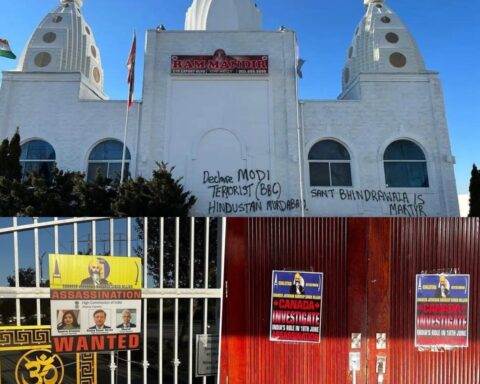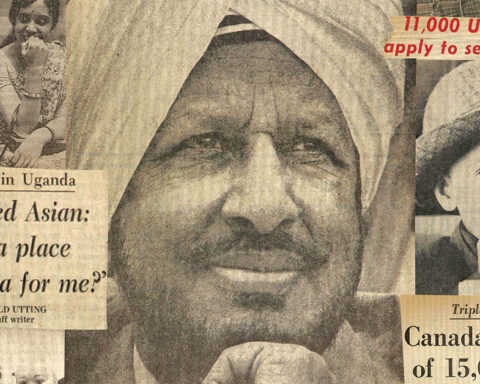Jagmeet Singh does not yet have a seat in the House of Commons. So when the new NDP leader comes to visit, he’ll have to sit up in the Leader of the Opposition’s Gallery and gaze down on the body he wishes someday to join.
If all the MPs are there that day, Singh may notice that there are already five turbaned Sikh men with seats. In 2015, 47 so-called “visible minority” MPs were elected along with 10 Indigenous people, very nearly mirroring their relative shares of the Canadian population.
If Singh then swings his eyes to the north end of the Commons chamber to the gallery above the Speaker’s Chair — to the Press Gallery, that is — he may notice something different. So far as I am aware, there has never been a turbaned man working as a reporter for a major news organization, so he won’t see any of those.
No one keeps racial statistics on the Press Gallery the way they do for the House of Commons, but when I looked through the membership list the other day, I was able to identify only one visible minority reporter working for one of the big legacy media outlets – a reporter at CTV. None at the Globe, none at the Star, none at CBC-TV. And no Indigenous people either.
This may overstate the case a little bit. Since I was a reporter on the Hill in the 1990s, there has been an influx of young reporters of colour. They tend to be concentrated in online and specialist publications such as HuffPost Canada, the Hill Times, the Aboriginal Peoples’ Television Network (APTN) and some ethnic and foreign news outlets. The so-called Mainstream Media — not so much.
The House of Commons is today much more representative of the face of modern Canada than is the Press Gallery. Most of us can name a few visible minority and Indigenous politicians. Try coming up with more than one or two political journalists of colour.
When Singh was chosen as NDP leader, there were two streams of news coverage, both echoing (in a small way) the reaction to Barack Obama’s breakthrough in 2008. The first was a self-congratulatory celebration of the nation’s inclusivity. The second involved an obsessive concern with the man’s race and ethnicity.
One interview that got a lot of attention was Terry Milewski’s welcome-to-Ottawa interview with Singh on CBC’s Power and Politics. Milewski has never suffered fools gladly and operates on the premise that all politicians are fools until proven otherwise. (Stephen Harper was never able to establish this to Milewski’s satisfaction, so far as I could see.)
Apparently Singh, or his office, had — with stunning naiveté — asked to see the questions in advance. Milewski delightedly tweeted out that fact before Singh backed down. Advantage: Milewski.
A lot of the reaction to Milewski’s interview turned around a “gotcha” section at the end of the interview in which Milewski doggedly asked Singh to denounce posters of Talwinder Singh Parmar, which appear in some Sikh-Canadian institutions. Parmar was a Sikh nationalist who was — it has been well-established — the mastermind behind the Air India bombing in which 329 people were killed, most of them Canadian, many of them of Indian extraction.
Except for Milewski’s first question — which was about how Singh would manage without a Commons seat — every single query directly or indirectly invoked race, religion or ethnicity.
For many viewers not steeped in the issue, it must have been a baffling exchange. But few reporters in Canada have covered the Air India bombing and its aftermath more thoroughly than Milewski — and Jagmeet Singh has been deeply engaged in Sikh politics. It may have been a ‘gotcha’ question, but it got Singh, who dodged and weaved but would not be caught denouncing Canada’s worst-ever mass murderer.
Singh is really going to have to do better than this if he wants to lead a national party with any success.
What concerned me about the Milewski interview was not this exchange, but what came before it. Except for the first question — which was about how Singh would manage without a Commons seat — every single query directly or indirectly invoked race, religion or ethnicity.
There were questions about refugees, religious symbols, Singh’s “acceptability” in Quebec — all coming before the Parmar exchange. Nothing on Singh’s interesting views on addressing precarious work among the young. Nothing on his controversial views on decriminalizing possession of drugs like cocaine and heroin. No “open-ended” questions that would allow Singh to lay out his own agenda.
Earlier that same day, another CBC journalist had posted a tweet that appeared to confuse Singh with another turbaned Sikh — federal economic development minister Navdeep Bains. If I were among the one-in-five people living in Canada who are visible minority, I might be tempted to wonder whether journalists who see a politician of colour see anything but the colour.
When we look south of the border — or across the Atlantic — it’s easy for Canadians to think of racism as a foreign problem. And I agree that we seem (for the moment) unusually blessed.
But take a look at some of the just-released data from Canadian Press’s important “Populism Project” – a survey from EKOS research. According to EKOS’ massive survey, 37 per cent of Canadians think too many immigrants are visible minority. Among respondents who are themselves visible minority, 43 per cent said they had “personally seen or experienced a clear incident of racism” over the past month. Remarkably, 26 per cent of other Canadians said the same.
While a plurality of Canadians don’t think there been much change in the level of racism in Canada, 33 per cent think racism is becoming more common, compared with 20 per cent who think it is becoming less common.
I am not suggesting for a moment that Sikh politicians should only be interviewed by Sikh journalists, or that Indigenous politicians (like the Manitoba NDP’s new leader Wab Kinew) should only be interviewed by Indigenous journalists. It’s a fundamental tenet of journalism that good reporters strive to understand the world around them, and strive particularly hard to understand those most different from them.
But a more diverse press corps would have two effects: one for journalists, the other for consumers of journalism.
For journalists, having people of various backgrounds in the newsrooms means being exposed to different sensibilities and story ideas in editorial meetings, over coffee, and in the thousands of chats that occur among colleagues in newsrooms every day as they try to figure out their angles. They also get to know individuals different from themselves in their full complexity — without reducing them to their most visible characteristics.
In the late 1980s, I did a story related to HIV/AIDS for the CBC. I had lived in New York at the height of the crisis a few years earlier and thought I was reasonably well informed. But after my story aired, a young producer — who was gay — came and spoke to me about some of the language I had used. He made me a better journalist by helping me see some things I had overlooked.
We are all limited to some degree by our backgrounds. Journalism is a lifelong process of educating ourselves away from those limitations.
For news consumers, diverse newsrooms are both a substantive and a symbolic indication that the news business is serious about exploring our world, which includes people like ourselves and people who are quite different. It’s not just about comforting visible minorities through representation. It’s also about the rest of us not just seeing them, but trying to understand them.
The views, opinions and positions expressed by all iPolitics columnists and contributors are the author’s alone. This piece was republished under arrangement with iPolitics.




